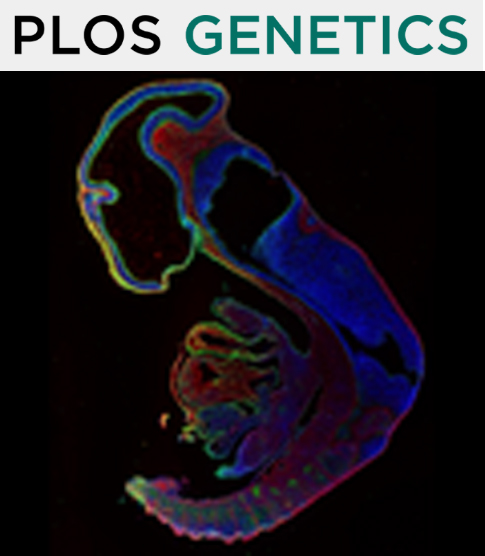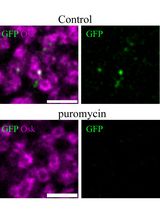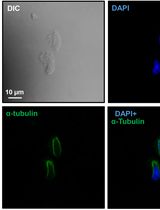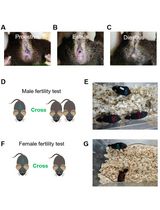- EN - English
- CN - 中文
Three-color dSTORM Imaging and Analysis of Recombination Foci in Mouse Spread Meiotic Nuclei
小鼠扩散型减数分裂细胞核中重组病灶的三色dSTORM成像及分析
(*contributed equally to this work) 发布: 2023年07月20日第13卷第14期 DOI: 10.21769/BioProtoc.4780 浏览次数: 1905
评审: Xiaokang WuJames H. CrichtonAnonymous reviewer(s)
Abstract
During the first meiotic prophase in mouse, repair of SPO11-induced DNA double-strand breaks (DSBs), facilitating homologous chromosome synapsis, is essential to successfully complete the first meiotic cell division. Recombinases RAD51 and DMC1 play an important role in homology search, but their mechanistic contribution to this process is not fully understood. Super-resolution, single-molecule imaging of RAD51 and DMC1 provides detailed information on recombinase accumulation on DSBs during meiotic prophase. Here, we present a detailed protocol of recombination foci analysis of three-color direct stochastic optical reconstruction microscopy (dSTORM) imaging of SYCP3, RAD51, and DMC1, fluorescently labeled by antibody staining in mouse spermatocytes. This protocol consists of sample preparation, data acquisition, pre-processing, and data analysis. The sample preparation procedure includes an updated version of the nuclear spreading of mouse testicular cells, followed by immunocytochemistry and the preparation steps for dSTORM imaging. Data acquisition consists of three-color dSTORM imaging, which is extensively described. The pre-processing that converts fluorescent signals to localization data also includes channel alignment and image reconstruction, after which regions of interest (ROIs) are identified based on RAD51 and/or DMC1 localization patterns. The data analysis steps then require processing of the fluorescent signal localization within these ROIs into discrete nanofoci, which can be further analyzed. This multistep approach enables the systematic investigation of spatial distributions of proteins associated with individual DSB sites and can be easily adapted for analyses of other foci-forming proteins. All computational scripts and software are freely accessible, making them available to a broad audience.
Key features
• Preparation of spread nuclei, resulting in a flattened preparation with easy antibody-accessible chromatin-associated proteins on dSTORM-compatible coverslips.
• dSTORM analysis of immunofluorescent repair foci in meiotic prophase nuclei.
• Detailed descriptions of data acquisition, (pre-)processing, and nanofoci feature analysis applicable to all proteins that assemble in immunodetection as discrete foci.
Graphical overview

Background
Many studies describe analyses using spread meiotic nuclei and immunofluorescence to visualize proteins involved in chromosome pairing and DNA double-strand break (DSB) repair. This mostly involves (fluorescent) light microscopy, which has the benefit of multi-color imaging but limited spatial resolution, restricted to ~250 nm. Electron microscopy overcomes this diffraction limit but has its pitfalls in complicated time-consuming sample preparation and limited labeling possibilities. Still, electron microscopy has revealed details of the two lateral elements of the synaptonemal complex (SC), forming between two homologous chromosomes during meiotic prophase and spaced ~200 nm apart, that were not resolved in light microscopy (Barlow et al., 1993).
To elucidate the spatiotemporal localization of proteins in meiosis, combining high resolution with imaging of multiple proteins is critical, and this possibility became a reality upon the development of super-resolution microscopy techniques (Cremer and Cremer, 1978). One type is single-molecule localization microscopy (SMLM), where blinking fluorophores are precisely localized in a sample, currently yielding the highest resolution in light microscopy (~5–20 nm). Direct stochastic optical reconstruction microscopy (dSTORM) is an indirect SMLM technique using fluorophores conjugated to antibodies bound to target proteins (Betzig et al., 2006; Rust et al., 2006).
dSTORM microscopy is very suitable for applications on spread meiotic nuclei due to the thin-layered chromatin preparations, low background achieved through the loss of most freely diffusing proteins, and the availability of a toolbox of well-characterized antibodies. We are interested in the localization patterns of two proteins involved in meiotic DNA DSB repair, RAD51 and DMC1, in the context of chromosome pairing, using SYCP3 as a marker of the lateral elements of the SC. Here, we describe an improved version of the nuclear spreading protocol that originates from Peters et al. (1997) in terms of optimal spreading quality, reproducibility, and suitability for dSTORM microscopy. For example, the requirement for coverslips rather than microscopy slides asked for some adaptations to ensure adherence of nuclei to the coverslip (coating step) and to avoid handling the vulnerable coverslips as much as possible.
Previously, we performed two-color dSTORM of recombinases RAD51 and DMC1 (Slotman et al., 2020) and recently expanded this to three-color dSTORM in combination with semi-automated selection of recombination foci (Koornneef et al., 2022). Here, we present the detailed protocol for this optimized pipeline, including the improved spreading procedure, immunofluorescent sample preparation, dSTORM data acquisition, pre-processing, and data analysis. Three-color dSTORM analyses allow high-resolution features to be discriminated, such as the precise position of each lateral element relative to the recombinase(s), to assess whether a particular recombinase is in close proximity with these components of the SC or localizes in the central area or outside the SC. The updated nuclear spreading protocol is specifically of interest to the meiosis community but might also be tested for other cell types. In addition, irrespective of the sample fixation protocol, the data acquisition, pre-processing, and data analysis described in this protocol are generally applicable and of interest to a broad public working on super-resolution microscopy in different fields.
Materials and reagents
Note: Materials and reagents not provided with company and catalog number information can be ordered from any qualified company for this experiment.
Biological materials
Laboratory-bred mice
Note: Mice were socially housed in individually ventilated cages with food and water ad libitum, in 12:12 h light/dark cycles.
Reagents
Paraformaldehyde (PFA) (Sigma-Aldrich, catalog number: P6148), storage temperature: 4 °C
dH2O
Sodium hydroxide (NaOH) (Honeywell, catalog number: 06203)
Sodium tetraborate decahydrate (Na2B4O7·10H2O) (Honeywell, catalog number: 31457)
Triton X-100 (Sigma-Aldrich, catalog number: T9284), storage temperature: room temperature (RT)
DPBS (Gibco, catalog number: 14190094), storage temperature: RT
Calcium chloride dihydrate (CaCl2·2H2O) (Sigma-Aldrich, catalog number: C7902)
Magnesium chloride hexahydrate (MgCl2·6H2O) (Honeywell, catalog number: M9272)
Sodium DL-lactate (Sigma-Aldrich, catalog number: L4263), storage temperature: 4 °C
Sucrose (Sigma-Aldrich, catalog number: 84097), storage temperature: RT
Tris base (Tris) (Sigma-Aldrich, catalog number: T6066)
Sodium citrate tribasic dihydrate (Sodium citrate) (Sigma-Aldrich, catalog number: 71406)
Ethylenediaminetetraacetic acid disodium salt dihydrate (EDTA) (Sigma-Aldrich, catalog number: E1644)
DL-Dithiothreitol (DTT) (Sigma-Aldrich, catalog number: D0632), storage temperature: 4 °C
Hydrochloric acid (HCl) (Honeywell, catalog number: 30721)
CO2 gas
Photo Flo (Kodak, catalog number: 5010640), storage temperature: RT
Sodium phosphate dibasic dihydrate (Na2HPO4·2H2O) (Sigma-Aldrich, catalog number: 71645)
Potassium dihydrogen phosphate (KH2PO4) (Sigma-Aldrich, catalog number: 04243)
Potassium phosphate monobasic (KCl) (Honeywell, catalog number: 60220)
Sodium chloride (NaCl) (Sigma-Aldrich, catalog number: 71380)
Bovine serum albumin fraction V (BSA) (Roche, catalog number: 10735086001), storage temperature: 4 °C
Skim milk powder (Sigma-Aldrich, catalog number: 70166), storage temperature: RT
Mouse monoclonal anti-DMC1 (Abcam, catalog number: ab11054), aliquot storage temperature: -80 °C, stock concentration: 1 mg/mL
Note: After thawing an aliquot, the remainder is refrozen and then stored at -20 °C. Aliquot volumes were calculated to be sufficient for approximately 3–4 immunostainings to limit the number of freeze-thaw cycles.
Rabbit polyclonal anti-RAD51 [gift from R. Kanaar, previously generated and described by Essers et al. (2002)], aliquot storage temperature: -80 °C
Note: This antibody was stored at 4 °C after thawing.
Guinea pig anti-SYCP3 [gift from R. Benavente, previously generated and described by (Alsheimer and Benavente, 1996)], aliquot storage temperature: -20 °C
Notes:
This antibody was stored at 4 °C after thawing.
As an alternative to visualize SYCP3, we recommend using a mouse monoclonal antibody (Abcam, catalog number: ab97672).
Goat serum (Sigma-Aldrich, catalog number: G9023), storage temperature: -20 °C
Goat anti-guinea pig IgG Alexa 647 (Abcam, catalog number: ab150187), aliquot storage temperature: -80 °C, stock concentration: 2 mg/mL
Goat anti-rabbit IgG CF568 (Sigma-Aldrich, catalog number: SAB4600310), aliquot storage temperature: -20 °C, stock concentration: ~2 mg/mL
Goat anti-mouse IgG Atto488 (Rockland, catalog number: 610-152-121S), aliquot storage temperature: -20 °C, stock concentration: 1 mg/mL
Note: All secondary antibodies were stored at 4 °C after thawing. Please note that the quality of all antibodies decreases over time.
TetraSpeckTM microspheres 100 nm (Thermo Fisher, catalog number: T7279)
D-(+)-Glucose anhydrous (Sigma-Aldrich, catalog number: 49139)
Catalase (Sigma-Aldrich, catalog number: C9322)
Glucose oxidase (Sigma-Aldrich, catalog number: G2133)
Cysteamine hydrochloride (MEA) (Sigma-Aldrich, catalog number: M6500)
Immersion oil: ImmersolTM 518 F (Carl Zeiss, Jena, catalog number: 4449640000000)
Solutions
1 M NaOH (see Recipes)
50 mM borate buffer (see Recipes)
1.1 M CaCl2·2H2O (see Recipes)
0.5 M MgCl2·6H2O (see Recipes)
100 mM sucrose (see Recipes)
Hypobuffer (see Recipes)
Coated coverslips (see Recipes)
0.08% photo Flo (see Recipes)
20× PBS (see Recipes)
1× PBS (see Recipes)
Blocking buffer 1 (see Recipes)
Primary antibody buffer (see Recipes)
Blocking buffer 2 (see Recipes)
5 M NaCl (see Recipes)
1 M Tris-HCl pH 8 (see Recipes)
5× glucose (see Recipes)
dSTORM enzymes (see Recipes)
25 mM MEA (see Recipes)
Recipes
1 M NaOH
40 g of NaOH
Add dH2O up to 1 L
50 mM borate buffer
3.81 g of Na2B4O7·10H2O
Add dH2O up to 200 mL
Adjust the pH to 9.2 with 1 M NaOH
1.1 M CaCl2·2H2O
1.62 g of CaCl2·2H2O
Add dH2O up to 10 mL
Prepare 0.5 mL aliquots and store them at RT
0.5 M MgCl2·6H2O
1.02 g of MgCl2·6H2O
Add dH2O up to 10 mL
Prepare 0.5 mL aliquots and store them at RT
100 mM sucrose
3.42 g of sucrose
Add dH2O up to 100 mL
Prepare 1 mL aliquots and store them at -20 °C
Hypobuffer
1 mL of 600 mM Tris HCl pH 8.2 (0.73 g of Tris base in 10 mL of dH2O)
2 mL of 500 mM sucrose pH 8.2 (3.42 g of sucrose in 20 mL of dH2O)
2 mL of 170 mM sodium citrate pH 8.2 (0.50 g of sodium citrate in 10 mL of dH2O)
200 μL of 500 mM EDTA pH 8.2 (1.86 g of EDTA in 10 mL of dH2O)
100 μL of 100 mM DTT (0.15 g of DTT in 10 mL of dH2O)
14.7 mL of dH2O
Add dH2O up to 5 mL
Prepare 1 mL aliquots and store them at -20 °C
Note: All components for this buffer should be individually calibrated to a pH of 8.2 (except for DTT).
Coated coverslips
Boil the coverslips in dH2O for 20 min in the microwave (900 W)
Let them air dry
Coat the dry coverslips with 0.01% poly-L-lysine
Mix 3 mL of 0.1% poly-L-lysine with 27 mL of dH2O in a 15 cm Petri dish and put the dry boiled coverslips in the solution for 5 min at RT
Let the coverslips dry in an incubator at 60 °C for 1 h by placing them against the side of a 6-well plate
0.08% photo Flo
160 μL of photo Flo
Add dH2O up to 200 mL
Note: Prepare this just prior to use.
20× PBS
178 g of Na2HPO4·2H2O
24 g of KH2PO4
20 g of KCl
800 g of NaCl
Add dH2O up to 4 L
Adjust the pH to 7.4 with NaOH
Add dH2O up to a final volume of 5 L
1× PBS
45 mL of 20× PBS
Add dH2O up to 900 mL
Blocking buffer 1
0.25 g of BSA
0.25 g of skim milk powder
Add 1× PBS up to 50 mL
Make 1 mL aliquots and store them at -20 °C
Note: Thaw before use.
Primary antibody buffer
1 g of BSA
Add 1× PBS up to 10 mL
Make 1 mL aliquots and store them at -20 °C
Note: Thaw before use.
Blocking buffer 2
0.5 g of skim milk powder
Add 1× PBS up to 10 mL
Centrifuge for 10 min at maximum speed in an Eppendorf centrifuge
Transfer the supernatant to a new tube and add 10% of normal goat serum
Note: Prepare this just prior to use.
5 M NaCl
29.2 g of sodium chloride
Add dH2O up to 100 mL
1 M Tris-HCl pH 8
12.11 g of Tris
Add dH2O up to 80 mL
Adjust the pH to 8 with HCl
Add dH2O up to a final volume of 100 mL
5× glucose
20 g of glucose
10 mL of 1 M Tris-HCl pH 8
400 μL of 5 M NaCl
15 mL of dH2O
Dissolve glucose and add dH2O up to a final volume of 40 mL
Notes:
Thaw before use.
Heating can speed up the dissolving process.
dSTORM enzymes
56 mg/mL glucose oxidase, 3.4 mg/mL catalase in 50 mM Tris-HCl pH 8 and 10 mM NaCl
Mix 5 μL of 5 M NaCl, 125 μL of 1 M Tris-HCl pH 8, and 2.37 mL of dH2O.
Let the catalase thaw completely. When thawed, weigh 3.4 mg of catalase and dissolve it in 1 mL of NaCl/Tris-HCl solution. For 10KU glucose oxidase: check the U/g (in our case, 224890 U/g) to calculate the quantity in grams. 10,000/224,890 = 44.5 g of glucose oxidase.
For 56 mg/mL, use 44.5/56 = 795 μL of the catalase/NaCl/Tris-HCl solution. Add this volume of solution to the storage tube of glucose oxidase and dissolve well.
Prepare aliquots of 30 μL and store at -20 °C. Thaw before use.
25 mM MEA
10 μL of 5 M NaCl
250 μL of 1 M Tris-HCl pH 8
0.57 g of MEA
Add dH2O up to 5 mL
Prepare 100 μL aliquots and store them at -20 °C
Note: Thaw before use.
Laboratory supplies
Note: Laboratory supplies not provided with company and catalog number can be ordered from any qualified company for this experiment.
Disposable gloves
Aluminum foil
Pipette tips
Crushed ice
0.2 μm syringe filter (Whatman, catalog number: WHA10462300)
50 mL syringe (B.Braun, catalog number: 4616502F)
1.5 mL reaction tube (Greiner Bio-One, catalog number: 616201)
50 mL tube (Greiner Bio-One, catalog number: 227285)
10 cm Petri dish (Sarstedt, catalog number: 83.3902)
15 mL tube (Sarstedt, catalog number: 62554502)
10 mL pipette (Greiner Bio-One, catalog number: 607180)
24 mm diameter No. 1.5H (170 ± 5 μm) high precision round coverslips (Marienfield, catalog number: 0117640)
0.1% poly-L-lysine (Sigma-Aldrich, catalog number: P8920), storage temperature: RT
15 cm Petri dish (Sarstedt, catalog number: 83.3903)
6-well plate (Greiner Bio-One, catalog number: 657165)
Microscopic slide (MLS, catalog number: JK41301)
35 mm Petri dish (Falcon, catalog number: 353001)
3MTM tape (Permanento, number: 202)
Parafilm (Sigma-Aldrich, catalog number: P7793)
Equipment
Note: Equipment not provided with company and catalog number can be ordered from any qualified company for this experiment.
250 mL beaker
100 mL graduated cylinder
Pipettes
Microwave
Magnetic stirring bar
Magnetic stirring plate with heating capacity (IKA, model: RET B)
Fume hood
pH meter
Timer
Nutator (Clay Adams, model: 421106)
Euthanasia chamber for mice
Scissors and tweezers to dissect the testis
Curved tweezers with fine points for disrupting the tubuli (e.g., VWR, catalog number: 232-0110)
Pipette controller
Benchtop centrifuge (Eppendorf, model: 5810R)
Counting chamber (VWR, catalog number: BRND718920)
Phase contrast & dark field microscope (Olympus, model: BX41)
Tweezer for handling the coverslip (e.g., VWR, catalog number: 232-0174)
Incubator (Lab-Line Instruments, model: 308-1)
Microscope slide box (with wet paper inside to make a humid chamber) (Kartell, catalog number: 278)
Ultra-low temperature freezer (Sanyo, model: MDF-794)
Wheaton Coplin staining jar (Merck, catalog number: S6016)
Tilt shaker (shaking plate) (Edmund Bühler, catalog number: WS-10)
Dark box to store 6-well plate
Microcentrifuge (Thermo Scientific, model: Pico 17)
AttofluorTM cell chamber (microscopic ring) (Thermo Fisher, catalog number: A7816)
Ultrasonic cleaner (Brandson, model: B200)
Microscope [Zeiss Elyra PS1 system with a 100× 1.46 NA oil immersion objective, Andor iXon DU897 EMCCD camera (512 × 512)]
Note: Any TIRF microscope with high-power lasers > 100 mW and a sensitive camera, sCMOS, or EMCCD can be used. However, the workflow described here using the ZEN software only runs on the Zeiss Elyra microscope.
Software and datasets
ZEN2012 SP5 FP3 (Carl Zeiss, version 14.0.18.201)
Fiji/ImageJ (version > 1.53t, National Institutes of Health, USA, https://imagej.nih.gov/ij/) (Schindelin et al., 2012)
R (version >3.0) (R CoreTeam, 2018)
RTools (version 4.0, https://cran.r-project.org/bin/windows/Rtools/rtools40.html)
RStudio (Posit, 2015, version 4.0.3)
SMoLR (Paul et al., 2019) (available at https://github.com/ErasmusOIC/SMoLR , on the GitHub page you can find details on how to install the software)
Fiji Plugin “STORM_Tools.jar” (available at https://github.com/ErasmusOIC/STORM_Tools/tree/Publication)
Custom data analysis pipelines in Fiji (available at https://github.com/ErasmusOIC/STORM_Tools/tree/Publication/Scripts/)
Fiji script “Align_dSTORM_channels.ijm”
Fiji script “Create_reference.ijm”
Fiji script “Create_multi-color_dSTORM_image.ijm”
Fiji script “ROI_selection.ijm”
Fiji script “Manual_ROI_selection.ijm”
Custom data analysis pipelines in R (available at https://github.com/ErasmusOIC/STORM_Tools/tree/Publication/R_Scripts/)
R script “R scripts for recombination foci analysis using dSTORM.R”
A test dataset for the data analysis pipeline is available via BioImage Archive (http://www.ebi.ac.uk/bioimage-archive) under accession number S-BIAD627. This data is part of the study described before (Koornneef et al., 2022).
Procedure
文章信息
版权信息
© 2023 The Author(s); This is an open access article under the CC BY-NC license (https://creativecommons.org/licenses/by-nc/4.0/).
如何引用
Koornneef, L., Paul, M. W., Houtsmuller, A. B., Baarends, W. M. and Slotman, J. A. (2023). Three-color dSTORM Imaging and Analysis of Recombination Foci in Mouse Spread Meiotic Nuclei. Bio-protocol 13(14): e4780. DOI: 10.21769/BioProtoc.4780.
分类
发育生物学 > 繁殖 > 生殖细胞
您对这篇实验方法有问题吗?
在此处发布您的问题,我们将邀请本文作者来回答。同时,我们会将您的问题发布到Bio-protocol Exchange,以便寻求社区成员的帮助。
提问指南
+ 问题描述
写下详细的问题描述,包括所有有助于他人回答您问题的信息(例如实验过程、条件和相关图像等)。
Share
Bluesky
X
Copy link












